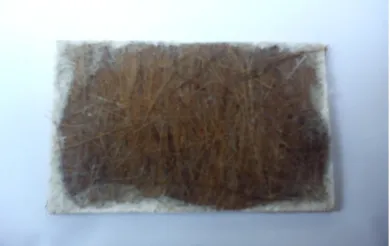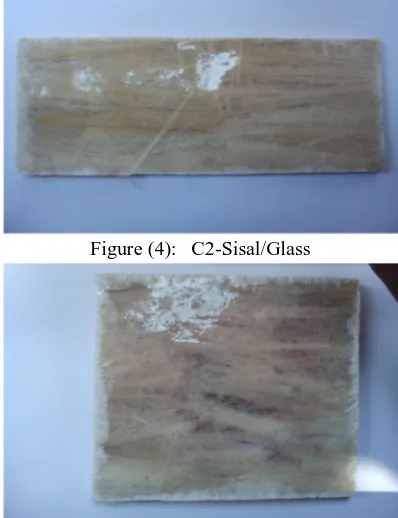Technology (IJRASET)
The Effect of Hybridization on Mechanical
Behavior of Natural / Glass Fiber Reinforced
Composites
P. Arunkumar1, P. Dhinakaran2, A. Dinesh Kumar3, R. Karthik4, M. A. Mohammed Riaz4
1,2
Assistant Professor, 4 UG Scholar, Mechanical Engineering
3
Assistant Professor, Mathematics
Dhanalakshmi Srinivasan Engineering College, Perambalur, Tamilnadu, India.
Abstract: The degree of mechanical reinforcement can be obtained by the introduction of glass fiber in biofiber reinforced polyester resin composites. Addition of relatively small amount of glass fiber to the biofiber reinforced polyester matrix enhances the mechanical properties of the hybrid composites. Biofiber is treated with alkali for the improvement of the fiber properties .The surface modification of biofibers such as alkali treatment produces optimum tensile and impact strengths. In order to determine the effects on the coir and sisal fiber composite with the alkali treatment, measures of characterizations will be carried out with the help of characterizing tools such as XRD, SEM. If this hybrid composite shows significant improvement in the characterization values it can be applied in the field of automobile and aerospace applications for weight reducing of the structure without sacrificing the strength.
Key Words: Biofiber, Matrix, Hand Lay-Up Technique.
I. INTRODUCTION
Fibre-Reinforced composites materials consist of fibers of high strength and modulus embedded in or bonded to a matrix with distinct interfaces between them. In this form, both fibers and matrix retain their physical and chemical identities. Yet they produce a combination of properties that cannot be achieved with either of the constituents acting alone. In general, fibers are the principle load carrying members, while the surrounding matrix keeps them in the desired location, acts as a load transfer medium between them, and protects them from environmental damages due to elevated temperatures and humidity. For example: The most common form in which composites are used in structural application is called as laminates. It is obtained by stacking a number of thin layers of fibers and matrix, and consolidating them into the desired thickness. Fibers orientation in each layer as well as the stacking sequence of various layers can be controlled to generate a wide range of physical and mechanical properties for the composite laminates.
II. MATERIALS
discontinuous fibers can be arranged either in unidirectional orientation or in random orientation. Discontinuous fibre-reinforced composites have lower strength and modulus than continuous fibre composites. However, with random orientation of fibers it is possible to obtain equal mechanical and physical properties in all directions in the plane of the lamina. The thickness required to support a given load or to maintain a given deflection in a fibre reinforced composites structure is obtained by stacking several laminas in a specified sequence and then consolidating them to form a laminate. Various laminas in a laminate may contain fibers either all in one
A. Fibers
Fibers are the major constituent in a fibre reinforced composite material. They occupy the largest volume fraction in a composite laminate and share the major portion of the load acting on a composite structure. Proper selection of fibre type, amount and orientation of fibers is a very important. It influences the following characteristics of a composite laminate.
Specific Gravity
Tensile Strength and Modules
Fatigue Strength and Fatigue Failure Mechanism Compressive Strength and Modules
Electrical and Thermal Conductivities Cost
High Strength and Stiffness Retention
B. Matrix
The role of matrix in a fibre reinforced composites are To transfer stresses between the fibers composites To provide a barrier against an adverse environment
To provide the surface of the fibers from mechanical abrasion
The matrix provides lateral support against the possibility of fibre buckling under compression loading, thus influencing to some extent the compressive strength of the composite materialsThe interaction between fibers and matrix is also important in designing damage tolerant structures. Finally the properties and defects in composite materials depend strongly on the physical and thermal characteristics such as viscosity, melting point and Curie temperature of the matrix.
III. MANUFACTURING METHODS OF COMPOSITES
There are many methods available for manufacturing composite material. Some of the advanced methods are discussed in this chapter. The most common methods by which the composites of various types are explained below.
Pultrusion Process
Resin Transfer Moulding Process Hand Lay-Up Technique Compression Moulding Process
A. Hand Lay-Up Process
Technology (IJRASET)
Figure (2): Hand Lay-Up Process 1) Advantages:Higher fibre contents and longer fibers than with spray lay-up Widely used for many years
Simple principles to teach.
Low cost tooling, if room temperature cure resins are used. Wide choice of suppliers and material types.
2) Disadvantages:Resin mixing, laminate resin contents, and laminate quality are very dependent on the skills of laminators.
Low resin content laminates cannot usually be achieved
IV.MATERIAL SELECTION AND TREATMENT
A. Materials
Glass fibre, Polyester resin, corresponding catalyst and accelerator such as Ethyl-Methyl Ketone and cobalt were obtained from M/s Leo chemicals Nagercoil and coir fiber are collected from local industries, Tenkasi.
B. Treatment
NaOH is used for the treatment of coir and sisal. The fiber mats were put in a vessel containing solution of NaOH with concentration of 5 % and a given pressure was applied to ensure good impregnation of NaOH solution. This was kept for 24 hr, after which the fiber mats were washed thoroughly with water to remove the excess of NaOH on the fibers and fiber mats were finally air dried at atmospheric temperature.
C. Specimen Preparation
[image:4.612.217.393.86.176.2] [image:4.612.211.406.582.705.2]Figure (4): C2-Sisal/Glass
Figure (5): C3-Coir/sisal/Glass
V. MECHANICAL TESTING
A. Impact Test
Impact strength is defined as the ability of a material to resist the fracture under stress applied at high speed. The impact properties of composite materials are directly related to its overall toughness. The following formula is used to calculate the impact strength, Impact strength=Impact Energy/ Area
B. Tensile Test
Tests are carried out on polyester resin and composite specimens to determine tensile strength, the specimens are prepared as per the ASTM D638 specification .The formula used for find out tensile strength as given below.
Tensile strength = P/A
C. Compression Test
Tests are carried out on polyester resin and composite specimens to determine compressive strength, the specimens are prepared as per the ASTM D3039-76 specification .The formula used for find out compression strength as given below.
Compression strength = P/A
D. Hardness Test
In all hardness tests, a define force is mechanically applied on the test piece for about 15 seconds. The indenter, which transmit the load to the test piece, varies in size and shape for different tests. In Brinell hardness testing, steel balls are used as indenter. Diameter of the indenter (D) and the applied force depend upon the thickness of the test specimen, because for accurate results. The indentation is measured and hardness calculated as BHN =
( ² ²)
VI. SCANNING ELECTRON MICROSCOPE
[image:5.612.78.528.44.359.2] [image:5.612.206.405.80.339.2]Technology (IJRASET)
information about the sample's surfacetopography, composition, and other properties such as electrical conductivity. The scanning electron microscope (SEM) uses a focused beam of high-energy electrons to generate a variety of signals at the surface of solid specimens. The signals that derive fromelectron-sample interactions reveal information about the sample including external morphology (texture), chemical composition, and crystalline structure and orientation of materials making up the sample.
VII. CONCLUSION
The materials such as (glass fiber, biofibers, polyester resin, catalyst and accelerator) that are required for the project are collected effectively. The hand lay-up technique is chosen for specimen preparations in addition to that the literature related to the project are also collected. Combination of samples (coir/glass fiber composite) has been prepared now,The characterizations will be carried out with the help of characterizing tools such as XRD, SEM. Based on the characterization values from the test it can be easily found out whether it can applied in the field of automobile and aerospace applications for weight reducing of the structure without sacrificing the strength.
REFERENCES
[1] Boeing, “Fibers composites for 7E7 Aircraft model”, composite for extreme environment. [2] Bajiuz. Babu, “Liquid composite moulding”, composite matrices.
[3] T. Bera and B. C. Ray, “Degradation Behaviors of Glass Fibre Reinforced polyester composites”, composite science and technology. [4] P. K. Mallick “Fibre reinforced composites” , 2007, CRC press.
[5] Compressive & impact properties of sisal/glass fiber reinforced hybrid composites Noorunnisha et al (2011). [6] Chemical Modification Effect on the Mechanical Properties of Coir Fiber Samia S. et al (2012).
[7] Effect of fiber treatments on tensile and thermal properties of starch/ethylene Vinyl alcohol copolymers/coir biocomposites Morsyleide F. Rosa et (2012) [8] Monteiro S N, Terrones LAH, D’Almeida JRM. Mechanical performance of coir fiber/polyester composites. Polymer Testing 2008; 27:591– 595. [9] Mishra, S, Mohanty A K, Drzal L T, Misra M, Parija S, Nayak S K, Tripathy, SS. Studies on mechanical performance of biofiber/glass reinforced
polyester hybrid composites.Composite Science Technology. 2003; 63:1377–1385.

